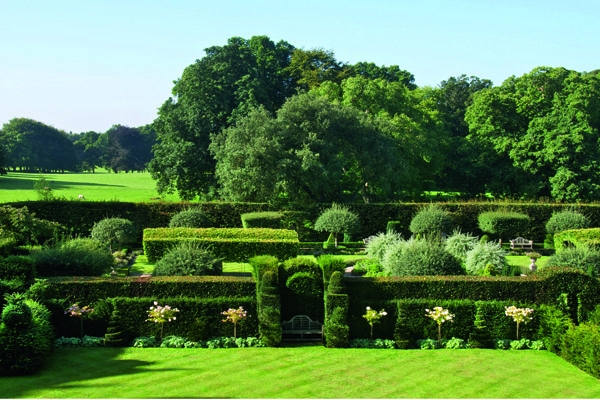Holker Hall is situated in a beautiful Cumbrian landscape within sight of Morecambe Bay, and in 1950 it became the second stately home, after Longleat, to be opened to the public. The house itself dates back to the 16th century, with a Victorian west wing replacing one that burned down in 1871. It is, however, the extensive park and gardens surrounding the house that have made it famous. Several generations of the Cavendish family have left their mark on this land, but the present garden is largely the creation of Hugh Cavendish — who was brought up at Holker and inherited it on his father’s death in 1972 — and his wife Grania.
Taking on an historic garden involves one fundamental decision: whether to preserve or to evolve. ‘Trying to preserve garden design is both futile and unexciting,’ Cavendish argues. ‘What is interesting is incorporating the noble relics of the past into the new.’
This view has clearly coloured his stint in charge of historic gardens and landscapes at English Heritage, an organisation with a distinctly patchy reputation as a custodian of the past. There is an underlying suggestion in A Time to Plant that gardens overseen and developed by their owners have an advantage over those that become part of the official heritage industry because they are not hampered by dogged, and sometimes deadly, historicism.
Like Christopher Lloyd at Great Dixter, Cavendish had no qualms about ripping out a rose garden which may originally have been the work of the well-known local designer Thomas Mawson (1861-1933). ‘South-west Cumbria can have 70 inches of rain in a wet year, and has hours of sunlight that are rather fewer than the national average,’ Cavendish writes firmly: ‘It is not rose country.’ The rose garden has therefore been ‘put out of its misery’ and replaced by a far more satisfactory sunken garden, with a pool, ‘mixed planting, some bedding out and an emphasis on scents’.
Although there are formal gardens close to the house, the chief glory of Holker is its collection of trees and shrubs, and it is these that Cavendish writes about in detail, allowing his wife’s photographs to speak for the herbaceous areas. The core of the book is a guided tour, which is quite hard to follow even with the help of the — rather splodgy — maps on the end-papers. One senses here Cavendish’s genuine passion for both the ‘noble relics’ and the rarities he has imported, and he occasionally makes acute observations such as: ‘How important to the visual aspect of a tree it is to see where it joins the ground.’
However, although he conveys the pleasure he derives from individual specimens, his actual descriptions of them are often more like those found in austere nursery catalogues, with none of the inventiveness or imagination-catching immediacy one finds in the work of such garden writers as Mirabel Osler or Katherine Swift.
Elsewhere, the book too often reads like a report to shareholders or the sort of speech made at a retirement party in which the skills, accomplishments and all-round niceness of those who have helped the Cavendishes create the garden are blandly and tediously itemised. The photographs, however, are uniformly excellent, making one want to rush immediately to Holker or even attempt to grow some of the plants depicted.






Comments